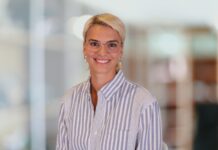
Dr. Moses Goddard is co-founder of Cytosolv Inc. in Providence and an associate professor of surgery at Brown University.
PBN: Could you explain the research being developed by Cytosolv?
GODDARD: Cytosolv was founded in April 2009 to develop and commercialize a new drug for improving the healing of skin wounds, starting with difficult-to-heal wounds like ulcers on the feet and legs of patients with diabetes. The drug is based on natural proteins called growth factors, which many different types of cells make and release into their environment, causing other cells nearby to grow, mature, multiply or do something else, depending on the growth factor and the target cell.
Growth factors have been a very active area of research since the 1970s, and there have been many attempts to develop them as drugs to treat all sorts of diseases – Parkinson’s disease, heart disease, and skin wounds to name just a few – but very few of these efforts have resulted in drugs that actually worked for humans. This has been a frustrating and expensive experience for everyone involved, and it has been especially disappointing because very careful experiments have clearly and repeatedly shown that many different growth factors can have extremely powerful positive effects on nerve tissue, heart muscle, skin, the brain and just about every other tissue in the body. Unfortunately, no one so far has been able to find the key to making one of these proteins into a truly useful drug to treat human disease.
Cytosolv has a relatively new strategy for solving this problem, but one that is starting to be more broadly respected in the scientific community. We have invented a drug that delivers growth factors the same way that the body does naturally – not as one single growth factor made by genetically engineered cells or bacteria (what previous drugs have done), but as a collection of many growth factors that are naturally produced by a unique type of tissue called the choroid plexus, a tissue which helps to maintain the environment around the brain. Our bodies normally produce at least hundreds of different growth factors and use them at very low doses in a complicated mix or sequence. Cytosolv’s drug imitates this natural process of providing many different factors at doses that are similar to the concentrations normally found in healthy tissues.
PBN: What sort of impact could the treatments Cytolsolv is developing have for patients? How might they see it?
GODDARD: The drug that Cytosolv is developing should be able to improve the healing of many different types of tissue, but we feel that skin is a logical place to start testing because it is easy to deliver drugs to areas of damage, and because there are a number of significant skin conditions that could benefit from an effective drug to improve wound healing.
The first indication that we plan to address is diabetic ulcers, the troublesome, very difficult-to-heal skin ulcers that form on the feet and lower legs of generally older diabetic patients, and which all too often result in severe infections and even amputations. A success for our drug would be to demonstrate that we can reduce the time required for these ulcers to heal. Since these ulcers often take literally months to heal, it is reasonable to think that our drug may be able to cut several weeks off the healing time of these ulcers, resulting in improved patient comfort and convenience, reduced complications from infections, and reduced costs of care.
PBN: When and how did you decide your research was unique enough to build a company around it?
GODDARD: There have been a number of attempts before us to develop growth factor-based drugs for treating diabetic ulcers, and all of them have failed to provide truly robust improvements in human patients. Any benefit that it may have been able to show in one clinical trial is not reflected in the real world. One drug has received FDA approval, but it is not doing well in the marketplace, in part because [of a lack] meaningful clinical improvements that doctors and patients recognize. All of these earlier drugs were evaluated in some sort of animal model of wound-healing before they were tested in humans, and all of them demonstrated some level of effectiveness in terms of accelerating the healing of skin wounds in those models. So what is different about the Cytosolv drug?
First of all, the Cytosolv drug has shown a stronger wound-healing effect in the standard wound-healing models than is reported in publications for the other, earlier drugs. Open wounds (similar to diabetic ulcers) heal more quickly with the Cytosolv drug than with the earlier drugs, and wounds that are sutured closed gain more strength faster with the Cytosolv drug than with the earlier drugs. But the really unique and surprising thing about our drug is that early testing demonstrates that when the drug is used the skin heals with much less scarring than it does in wounds without treatment, and the newly formed skin actually contains structures like hair follicles and sweat glands which are almost never seen in wound scars. This finding implies that the drug may actually stimulate regeneration of all of the layers of skin. This is the first time that I know of that an experimental drug has been able to show this, and it suggests a much more profound wound-healing benefit than was seen with earlier experimental drugs.
PBN: Cytosolv received $500,000 from the Slater Technology Fund, the state-backed venture capital organization, which was one of its two biggest investments last year. How has that money helped you?
GODDARD: Slater has been an absolutely essential investor and partner in the start-up of Cytosolv, valuable not only for the money that they have loaned to us, but also for the guidance and advice that Richard Horan of the Slater Fund has provided. Cytosolv is unusual among biotech startups in that the invention that the company is based on was not conceived of and developed in a university setting or in an already established company. Because of this it would have been very difficult for Cytosolv to secure grant funding from the National Institutes of Health or startup funds from venture capital firms, because it was too “virtual” to be credible in our field, no matter what our preliminary data showed. The Slater loan has allowed us to rent lab space, support employees, strengthen the experimental data for our drug, and work on our manufacturing process – all of which will make us much more likely to succeed in our next round of funding efforts.
PBN: You also received an investment from Living Cell Technologies Ltd., a company in New Zealand. How did that connection get made?
GODDARD: LCT is a company that is trying to develop a drug to treat diabetes based on taking insulin producing cells from pigs, enclosing the cells in a capsule that prevents immune rejection, and then implanting the encapsulated cells in the abdominal cavity of diabetic patients – a technology very similar to what was developed by CytoTherapeutics / Stem Cells Inc., a biotech founded and formerly located in Rhode Island. Everyone working at Cytosolv or involved in its founding has been associated with LCT in some way in the past as employees, consultants, or both. In fact, Cytosolv personnel continue to work on the LCT program through an ongoing consulting relationship. There are a number of very logical synergies between the two companies in terms of the skill sets, the technology and the sourcing of tissue for our respective products, and this has persuaded LCT to take an interest and to invest in our program. •












